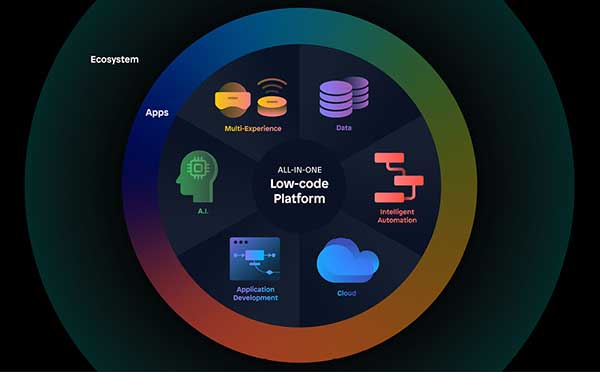Great News For Picking Legacy application modernization with Low-code
Wiki Article
Advantages Of Low-Code Application Development In Terms Of Speed
Visual Development Environment:
Drag-and-Drop Interfaces: Low-code platforms provide visual tools for designing applications. Drag-and-drop elements enable developers to rapidly build applications without having to write lengthy code.
Pre-built components and templates A lot of low-code platforms come with pre-built components as well as templates that allow developers to quickly build prototypes and build applications.
Coding needs that are reduced:
Automated Code Generation Low-code platforms automatically generate the code base on the visual models designed by the developers. This means that there is less manual code coding.
Reusable component: Developers can use the same components for different projects. This helps reduce time spent testing and writing code.
Collaboration can be streamlined.
Low-code platforms have a myriad of tools that allow seamless collaboration between development teams. These include version control, testing and deployment.
Citizen Development Developers, business users and other stakeholders are able to participate in application development through user interfaces that are intuitive. This eliminates the bottleneck created by the lack of availability of skilled developers.
Rapid Iteration and Prototyping:
Rapid Prototyping. Developers can create prototypes in a short time to validate their ideas as well as get feedback. This leads to a faster iteration cycle.
Easy Modifications: The visually-oriented design of low-code programming makes it simpler to make modifications and updates to applications, which speeds up the process of refining and improving applications based on user feedback.
Pre-built Integrations:
API Integrations: Platforms that are low-code often come with pre-built connectors for popular services and APIs, reducing the time required to integrate with external systems.
Data Integration: The tools integrated into the software simplify and speed up the process of connecting databases, applications and data sources.
Scaling and deployment:
One-Click-Deployment: Many Low-Code platforms have one-click deployment options. This reduces the time and effort needed to deploy an application.
Cloud-Based Solutions: Cloud-based low-code platforms can manage scaling and infrastructure management, allowing developers to focus on the logic of their applications and functions rather than the logistics of deployment.
The primary benefit of low-code application development with regard to speed, is its capacity to automatize and simplify many aspects of the development process. This allows for rapid delivery of software and faster adaptations to evolving needs. See the recommended helpful hints on Low-code Platform for application development for blog info including app dev platform, rad application development, rad application development, cross platform mobile development, push notifications android, azure sql databases, microsoft azure sql, mobile development platforms, build with docker, azure sql and more.

Low-Code Application Development Offers Many Benefits In Terms Of Cost-Effectiveness
Low-code development offers a number of advantages in terms of cost-effectiveness. Businesses seeking to reduce costs are able to benefit from this method while still delivering high-quality applications. The following are some key advantages.
Lower Coding Requirements: Low Coding platforms remove the requirement to code manually, saving developers both time as well as money. This results in lower labor costs.
Less Developer Resources: Because low-code development is quicker and simpler, fewer specialized developers are needed. It could reduce hiring and staffing costs.
More time to market:
Accelerated Development: Low-code platforms provide visually-based development tools, components that are pre-built and other capabilities that facilitate rapid development of software. Companies can launch their products to the market much faster. This can result faster revenue generation, and improved positioning in the market.
Rapid Prototyping. Through the rapid creation and testing prototypes, businesses can reduce time spent on development and improve their product faster based on feedback from users.
Low Maintenance Costs
Simpler Maintenance: Low-code platforms, with their modular design and components that are standardised make them easier to maintain. This helps reduce the cost of maintaining the system over time.
Automated Updates Many low-code systems are capable of managing updates and patches in a manner that is safe and efficient. This means that there is no requirement to manually intervene.
Efficient Resource Utilization:
Contributions from non-developers: Low-code platforms enable people who are not developers to take part in the development process. This democratization of development processes enables businesses to utilize the skills and talents of a wider range of employees.
IT departments can concentrate on Strategic Initiatives instead of being overwhelmed by the daily tasks of development, IT departments are able concentrate their efforts on strategic initiatives that increase productivity and efficiency.
Scalable Pricing Models:
Subscription Pricing: Many platforms that use low-code provide flexible pricing models that are based on subscriptions that are scaled depending on usage. This allows businesses to alter their budgets to meet their growth and requirements without paying huge upfront costs.
Pay-as-you-go: Certain platforms offer pay-as you-go options. This allows businesses to only pay for the resources they actually use. This is especially beneficial for startups and small-sized businesses that have limited funds.
Reduced costs of third-party software:
Built-in Functionalities: Low-code systems usually come with built-in functionalities and integrations that minimize the need for additional third-party software and tools, leading to savings on software licensing and subscription fees.
Pre-Built integrations: These pre-built systems and services are integrated with well-known services, reducing the need for custom-built software and saves both time and money.
Increased ROI
Increased Return on Investment: Combining rapid development with lower costs and a quicker speed to market, companies will see a greater ROI on their investments (ROI).
Increased Agility: Businesses are able to quickly adapt to market changes and demands of their customers and ensure that they remain current and take advantage of emerging opportunities when they occur.
Lower Cost of Training:
User-Friendly Interfaces: The simple, user-friendly interfaces of low-code platforms cut down on the learning curve for new users, and reduce the need for lengthy training programs.
Accessible resources Low-code platforms often have complete tutorials, instructional materials, as well as community support and help, which can reduce the need for formal education.
Collaboration is simplified:
Enhance Collaboration Tool: The built-in collaboration tool improves communication and cooperation among team members. This leads to more efficient development processes, and also reduces the cost of projects.
Unified Development Environment: A single, unified development environment helps improve workflows and reduces cost and complexity of managing multiple platforms and tools.
In general, low-code apps are cost-effective because of their ability to reduce costs for development and maintenance and to speed up time-to-market to optimize the use of resources and also to offer an affordable pricing. These factors deliver significant economic benefits to businesses, making low code a compelling option for organizations looking to maximize their budgets and create quality, robust, and scalable apps. Follow the most popular Legacy application modernization with Low-code for blog advice including rapid action development, multiplatform mobile app development, developing mobile apps, rapid action development, database in azure, application development platforms, jdbc server, rad development, developing mobile apps, application modernization software and more.

Benefits Of Low-Code Application Development In Terms Of Community Support And Vendor Support
Low-code development platforms for applications provide significant advantages in terms of the support provided by vendors and communities. These is essential to ensure successful implementation, ongoing maintenance, and continuous improvement of applications. Here are the top benefits:Vendor support
Comprehensive Technical Support:
Dedicated Support Teams: Many low-code platforms have access to dedicated support teams that can assist in technical problems, troubleshooting, and help, making sure that any problems are resolved quickly.
Help is accessible 24/7. Many vendors provide around-the-clock assistance which is particularly beneficial for companies that operate across different time zones.
Training and Onboarding
The structured training programs offered by vendors provide structured courses such as webinars or certification courses. This helps users quickly master the platform.
Personalized Onboarding: A lot of vendors provide personalized onboarding services to help new customers use the platform efficiently and adapt it to their specific requirements.
Regular Updates, Enhancements, and Enhancements:
Continuous Improvement: Lowcode platform vendors usually issue regular updates that include new features, performance improvements as well as security patches. This ensures that the platform is up-to date and secure.
Feedback Integration: A lot of companies incorporate feedback from users in their process of development. This ensures that the platform is able to adapt to the ever-changing needs and wants of their users.
Comprehensive Documentation:
Documentation: Detailed documentation is available for most products. It covers everything from the basics to the most advanced customisation. This can help users find solutions for themselves.
API References: The detailed API documentation helps developers integrate the low-code platform with other systems and customize their applications to be effective.
Consultation and Professional Services:
Expert Consulting. Vendors offer a range of consulting services, including architecture design along with strategic planning and platform implementations. They ensure that customers can maximize the potential of their platform.
Custom Development Services - Some companies offer custom development services to help with specific functions or integrations that aren't available out of the standard package.
Community Support
Active User Communities
Forums and Discussion boards: Many low-code platforms offer active online communities for users to exchange ideas, ask questions and collaborate.
User Groups and Meetups: User groups, both virtual and local and meetups offer opportunities for networking, learning and sharing your experiences with other users.
Knowledge Sharing and Collaboration:
Community-Contributed Resources: Users often share templates, modules, and extensions that they have developed, which can be reused or adapted by others, accelerating development and innovation.
Crowdsourced Solution Finding: The collective experience and wisdom of a group could be a great resource for solving difficult problems.
Learning and Development
Community-led Training: Many groups host workshops, sessions for training, and webinars. They are usually led by experienced users, who provide practical advice as well as advanced techniques.
Online Tutorials: Members of the community make and share a variety of online tutorials, how-tos and tutorials. These resources are made available to everyone.
Feedback and Influence
Product Feedback Channels. Community forums usually include channels that allow users to give feedback to the company. This feedback may influence the development and enhancement of features.
Beta Testing Programs. Members of the community that are active participate in beta-testing programs. They will get early access to the latest features on the platform as well as an the chance to influence the future of the platform.
Recognition and Assistance:
Many vendors offer community recognition programs. These programs reward active community members and include MVP programs.
Peer Support: Members of the community typically provide peer support offering their expertise and providing guidance to less experienced users, fostering a collaborative and a supportive atmosphere.
Overall, a robust vendor's support and an active, vibrant community provide a comprehensive support system for low-code development. Users will have the expertise and resources to create, deploy and maintain their application.
